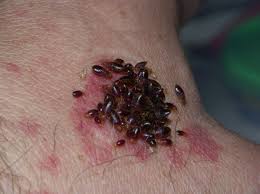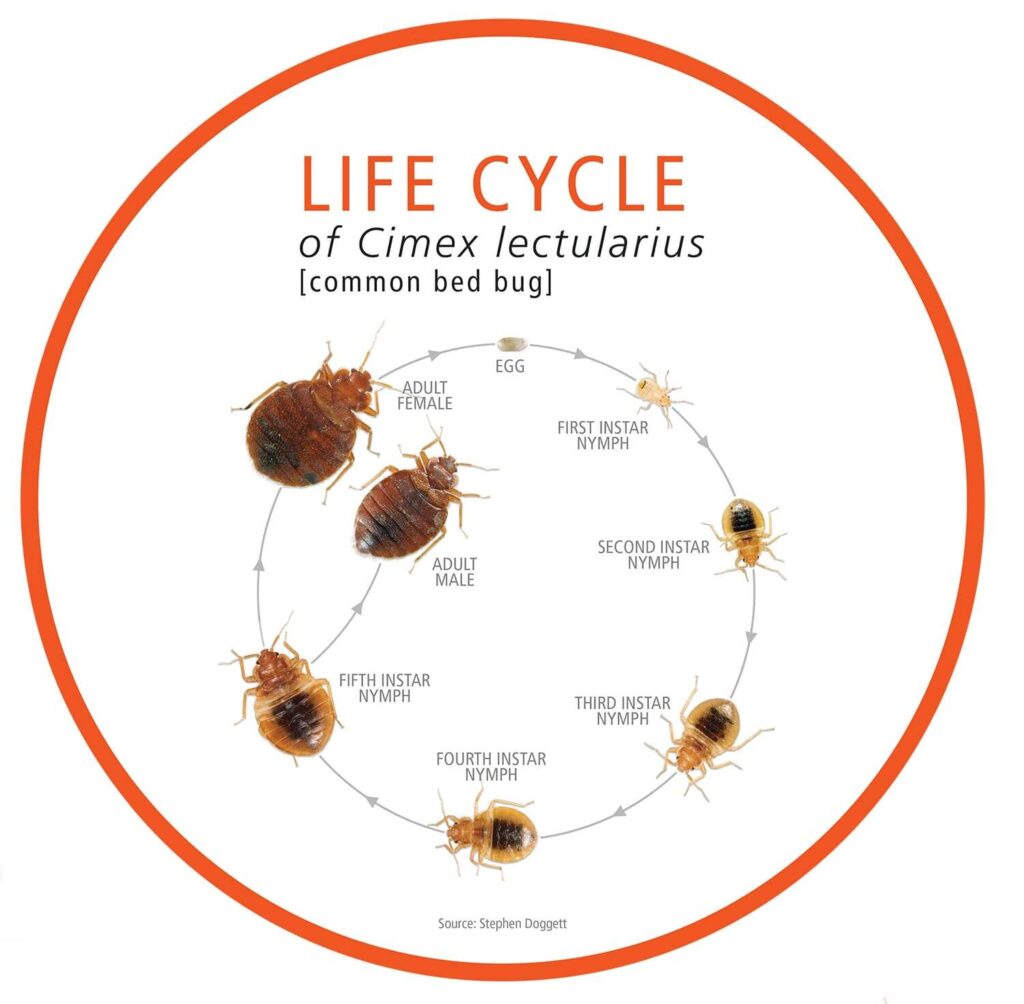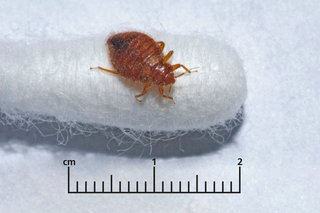any of several bloodsucking insects of the heteropterous genus Cimex, esp C. lectularius of temperate regions, having an oval flattened wingless body and infesting dirty houses: family Cimicidae.
While some pests might be drawn to dirty rooms or left out food, bedbugs don’t discriminate based on the cleanliness or sophistication of the place. This means that any hotel, motel, or bed and breakfast is susceptible to a bedbug outbreak. What it comes down to is having a fast, safe, and effective way to treat the problem the moment you notice your uninvited guests.





Bedbugs are small, nocturnal insects that feed on blood. Despite their name, bedbugs can be found in a variety of environments outside of bedding such as furniture, walls, office buildings, college dormitories etc. Recently bedbugs have undergone a massive resurgence and are quickly becoming a worldwide problem.

Adults are small, brownish insects, just under a ¼” (5mm) long and are relatively flat. They are nearly as wide as they are long, and oval in shape. Immature bedbugs (nymphs) resemble the adults, but are much smaller and lighter in color. Newly hatched nymphs are translucent and are no bigger than a pinhead (1mm).

How Do I Identify BedBugs?
Bedbugs need to be introduced into an environment. They do not jump or fly but are excellent hitch-hikers and can be transported on clothing, luggage, used furniture and various other objects. Risk for bedbug exposure increases in several of the following situations:
The most reliable way to confirm you have bedbugs is to contact an entomologist or pest management professional and have them identify a sample collected from your home. However, there are key warning signs that you may have an infestation:
No. Although bedbugs carry over 28 human pathogens, there has been no documented case of bedbugs transmitting disease.
The medical concerns of bedbugs are typically limited to the itching and inflammation associated with their bite. The bite effects are similar to allergic reactions and can vary from itchy welts to a severe and painful rash that requires medical attention. Often, the emotional trauma associated with discovering a bedbug infestation is considerable.
There are several steps that can be taken to minimize the risk of infestation:
Upon discovering an infestation, contact a licensed pest management professional to evaluate your problem. You may want to AVOID discarding bedding and mattresses as this can spread the infestation throughout the house. Also, AVOID attempting to resolve the issue yourself as improper treatment could spread the problem throughout and increase costs to eliminate the problem.
Bedbugs were a common problem during WWII. The use of DDT insecticides nearly eradicated the insect from North America and they have not been a significant problem for nearly 50 years. Although changes in pest management practices and increased international travel may be blamed for the resurgence of bedbugs, the lack of public awareness may be the primary reason these bugs continue to spread at their current rate.
Bedbugs have a long history intertwined with human civilization. Records of bedbugs date back to ancient Egypt, and they were a persistent problem throughout history. In the mid-20th century, bedbug infestations declined in developed countries due to the use of potent insecticides. However, the resurgence of bedbugs began in the late 1990s and early 2000s. Factors such as increased international travel, reduced public awareness, and the banning of certain insecticides contributed to their comeback. Bedbug infestations spread rapidly, causing distress and economic impacts. Ongoing efforts involve integrated pest management strategies and research to combat their resurgence effectively.
Bedbugs eat from the beginning of life until they die. All stages of life they bite and they will not stop until they are killed or die.

Using chemicals has become the norm for pest control companies and other businesses. But chemicals leave behind a residue that can be hazardous when someone is exposed to too much or for too long.
In fact, in 2012 the CDC — the Center for Disease Control and Prevention — issued a warning about the dangers of bedbug pesticides and the dangers that can come from using too much pesticide or exposure to these chemicals.
Chemicals can be effective in controlling and eliminating bedbugs, but there are several reasons why they may not always work or why professional intervention is often required:
Resistance: Over time, bedbugs have developed resistance to certain pesticides. Some populations of bedbugs have evolved genetic mechanisms that allow them to survive exposure to commonly used insecticides. This resistance can make it challenging to control bedbug infestations using chemical treatments alone.
Hiding and Egg Protection: Bedbugs are adept at hiding in tiny cracks and crevices, which can make it difficult for chemical treatments to reach them. Additionally, their eggs are resistant to many insecticides, so even if adult bedbugs are killed, the eggs can hatch and lead to a new infestation.
Incomplete Coverage: Effective bedbug control requires thorough treatment of all infested areas. If a treatment does not reach all hiding spots, even a small number of surviving bedbugs can repopulate and reinfest the area.
DIY Application Challenges: Applying insecticides properly to eliminate bedbugs can be complex. It requires knowledge of bedbug biology and behavior, as well as understanding how and where to apply the insecticides for maximum effectiveness. Improper application can lead to ineffective treatment and potential health risks.
Residual Effectiveness: Bedbugs can survive for months without feeding, so it’s important to use insecticides with a residual effect that continue to kill bedbugs over time. Some over-the-counter products may not have a long-lasting residual effect, making them less effective against bedbugs.
While chemicals can be part of the solution, it’s crucial to have a comprehensive approach that includes proper identification, professional expertise, and integrated pest management strategies to effectively address bedbug infestations.
Chemical treatments require, on average, 2.6 visits to completely eliminate a bedbug infestation. On top of that, industry data, scientific research, entomologists, and pest control experts have confirmed that the use of chemicals and insecticides for bedbug eradication is becoming less and less effective. That’s because bedbugs and other pests have evolved, making themselves resistant to certain chemicals by growing thicker exoskeletons or walking on their hind legs to better avoid over topical powders.
But, in many cases, using a heat treatment for bedbug eradication is effective in just one use with a median of 1.3 visits across the industry.
For years certain chemicals were successful and later discontinued or banned. Another generation of chemicals and compounds has replaced them and been used for several decades. Now entomologists are finding that bedbugs are becoming resistant to many of the commonly used chemicals. The typical suggestion is to increase the toxicity and amount of the chemicals being applied.
The genesis of most pest control companies is the chemical industry. The use of chemicals and the licensing of them for eradication has been the accepted standard process against a myriad of pests. However, that is not the case with bedbugs, according to current scientific research and field applications of chemicals
Did you know that bedbugs and other pests are building up a resistance to different extermination chemicals? This means that the chemicals need to be stronger or continually reformulated in order to keep pest problems under control. Industry data, scientific research, entomologists and pest control experts have confirmed that the use of chemicals and insecticides for bedbug eradication is becoming less and less effective.
Bedbugs are now resistant to many of the current chemicals being used, and some strains have even grown a thicker exoskeleton that prohibits chemical effectiveness. Some strains can even walk on their hind legs over topical powders so they have no effect in contacting the body.
Bedbug experts are finally realizing that the most effective and chemical-free way to get rid of any pest or bedbug problem is through temperatures they are unable to withstand.
Lethal temperatures for bedbugs range between 122° and 135° Fahrenheit.
All Eradi-Flo heaters get up to 155°F (68.3°C) to ensure all bed bugs and pests are effectively killed. Dead BedBugz industrial electric heater that will hold a temperature of 12s to 135°F for an extended period of time, you’ve found a chemical-free solution for ridding your property of bedbugs or other pests.
any of several bloodsucking insects of the heteropterous genus Cimex, esp C. lectularius of temperate regions, having an oval flattened wingless body and infesting dirty houses: family Cimicidae.


While some pests might be drawn to dirty rooms or left out food, bedbugs don’t discriminate based on the cleanliness or sophistication of the place. This means that any hotel, motel, or bed and breakfast is susceptible to a bedbug outbreak. What it comes down to is having a fast, safe, and effective way to treat the problem the moment you notice your uninvited guests.

Bedbugs are small, nocturnal insects that feed on blood. Despite their name, bedbugs can be found in a variety of environments outside of bedding such as furniture, walls, office buildings, college dormitories etc. Recently bedbugs have undergone a massive resurgence and are quickly becoming a worldwide problem.

What do bedbugs look like?
Adults are small, brownish insects, just under a ¼” (5mm) long and are relatively flat. They are nearly as wide as they are long, and oval in shape. Immature bedbugs (nymphs) resemble the adults, but are much smaller and lighter in color. Newly hatched nymphs are translucent and are no bigger than a pinhead (1mm).

How Do I Identify BedBugs?
Bedbugs need to be introduced into an environment. They do not jump or fly but are excellent hitch-hikers and can be transported on clothing, luggage, used furniture and various other objects. Risk for bedbug exposure increases in several of the following situations:
The most reliable way to confirm you have bedbugs is to contact an entomologist or pest management professional and have them identify a sample collected from your home. However, there are key warning signs that you may have an infestation:
No. Although bedbugs carry over 28 human pathogens, there has been no documented case of bedbugs transmitting disease.
The medical concerns of bedbugs are typically limited to the itching and inflammation associated with their bite. The bite effects are similar to allergic reactions and can vary from itchy welts to a severe and painful rash that requires medical attention. Often, the emotional trauma associated with discovering a bedbug infestation is considerable.
There are several steps that can be taken to minimize the risk of infestation:
Upon discovering an infestation, contact a licensed pest management professional to evaluate your problem. You may want to AVOID discarding bedding and mattresses as this can spread the infestation throughout the house. Also, AVOID attempting to resolve the issue yourself as improper treatment could spread the problem throughout and increase costs to eliminate the problem.
Bedbugs were a common problem during WWII. The use of DDT insecticides nearly eradicated the insect from North America and they have not been a significant problem for nearly 50 years. Although changes in pest management practices and increased international travel may be blamed for the resurgence of bedbugs, the lack of public awareness may be the primary reason these bugs continue to spread at their current rate.
Bedbugs have a long history intertwined with human civilization. Records of bedbugs date back to ancient Egypt, and they were a persistent problem throughout history. In the mid-20th century, bedbug infestations declined in developed countries due to the use of potent insecticides. However, the resurgence of bedbugs began in the late 1990s and early 2000s. Factors such as increased international travel, reduced public awareness, and the banning of certain insecticides contributed to their comeback. Bedbug infestations spread rapidly, causing distress and economic impacts. Ongoing efforts involve integrated pest management strategies and research to combat their resurgence effectively.
Bedbugs eat from the beginning of life until they die. All stages of life they bite and they will not stop until they are killed or die.

Using chemicals has become the norm for pest control companies and other businesses. But chemicals leave behind a residue that can be hazardous when someone is exposed to too much or for too long.
In fact, in 2012 the CDC — the Center for Disease Control and Prevention — issued a warning about the dangers of bedbug pesticides and the dangers that can come from using too much pesticide or exposure to these chemicals.
Chemicals can be effective in controlling and eliminating bedbugs, but there are several reasons why they may not always work or why professional intervention is often required:
Resistance: Over time, bedbugs have developed resistance to certain pesticides. Some populations of bedbugs have evolved genetic mechanisms that allow them to survive exposure to commonly used insecticides. This resistance can make it challenging to control bedbug infestations using chemical treatments alone.
Hiding and Egg Protection: Bedbugs are adept at hiding in tiny cracks and crevices, which can make it difficult for chemical treatments to reach them. Additionally, their eggs are resistant to many insecticides, so even if adult bedbugs are killed, the eggs can hatch and lead to a new infestation.
Incomplete Coverage: Effective bedbug control requires thorough treatment of all infested areas. If a treatment does not reach all hiding spots, even a small number of surviving bedbugs can repopulate and reinfest the area.
DIY Application Challenges: Applying insecticides properly to eliminate bedbugs can be complex. It requires knowledge of bedbug biology and behavior, as well as understanding how and where to apply the insecticides for maximum effectiveness. Improper application can lead to ineffective treatment and potential health risks.
Residual Effectiveness: Bedbugs can survive for months without feeding, so it’s important to use insecticides with a residual effect that continue to kill bedbugs over time. Some over-the-counter products may not have a long-lasting residual effect, making them less effective against bedbugs.
While chemicals can be part of the solution, it’s crucial to have a comprehensive approach that includes proper identification, professional expertise, and integrated pest management strategies to effectively address bedbug infestations.
Chemical treatments require, on average, 2.6 visits to completely eliminate a bedbug infestation. On top of that, industry data, scientific research, entomologists, and pest control experts have confirmed that the use of chemicals and insecticides for bedbug eradication is becoming less and less effective. That’s because bedbugs and other pests have evolved, making themselves resistant to certain chemicals by growing thicker exoskeletons or walking on their hind legs to better avoid over topical powders.
But, in many cases, using a heat treatment for bedbug eradication is effective in just one use with a median of 1.3 visits across the industry.
For years certain chemicals were successful and later discontinued or banned. Another generation of chemicals and compounds has replaced them and been used for several decades. Now entomologists are finding that bedbugs are becoming resistant to many of the commonly used chemicals. The typical suggestion is to increase the toxicity and amount of the chemicals being applied.
The genesis of most pest control companies is the chemical industry. The use of chemicals and the licensing of them for eradication has been the accepted standard process against a myriad of pests. However, that is not the case with bedbugs, according to current scientific research and field applications of chemicals.
Did you know that bedbugs and other pests are building up a resistance to different extermination chemicals? This means that the chemicals need to be stronger or continually reformulated in order to keep pest problems under control. Industry data, scientific research, entomologists and pest control experts have confirmed that the use of chemicals and insecticides for bedbug eradication is becoming less and less effective.
Bedbugs are now resistant to many of the current chemicals being used, and some strains have even grown a thicker exoskeleton that prohibits chemical effectiveness. Some strains can even walk on their hind legs over topical powders so they have no effect in contacting the body.
Bedbug experts are finally realizing that the most effective and chemical-free way to get rid of any pest or bedbug problem is through temperatures they are unable to withstand.
Lethal temperatures for bedbugs range between 122° and 135° Fahrenheit.
All Eradi-Flo heaters get up to 155°F (68.3°C) to ensure all bed bugs and pests are effectively killed. Dead BedBugz industrial electric heater that will hold a temperature of 122 to 135°F for an extended period of time, you’ve found a chemical-free solution for ridding your property of bedbugs or other pests.
Call (303) 532-2494
Call (303) 532-2494
Enter the following code in the promo coupon and receive 15% off on your next purchase.
Enter the following code in the promo coupon and receive 15% off on your next purchase.
